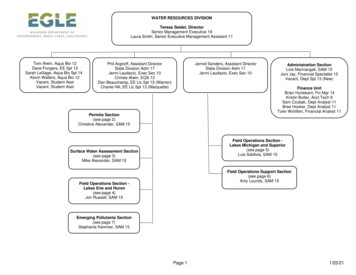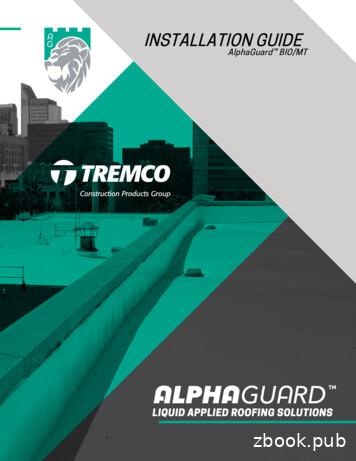Extraction Of Bio-fuel From Algae By Anaerobic Digestion
e-ISSN: 2349-9745p-ISSN: 2393-8161Scientific Journal Impact Factor (SJIF): 1.711International Journal of Modern Trends in Engineeringand Researchwww.ijmter.comExtraction of Bio-Fuel from Algae by Anaerobic DigestionHarihara Subramaniam S C1, Aashish Kumar2, Anand Murthy31,2,3St.Joseph‟s College of EngineeringAbstract---The growing energy demand across the globe has instigated us to synthesize bio-fuelfrom algae, a renewable resource. Algae Botryococcus braunii when subjected to anaerobic digestionand broken down by enzymes liberate methane and CO2. The CO2 obtained is cultivated in openponds and are passed through a fluidised bed chamber after pre-treatment. The chamber containsenzymes which breakdown the algal colloid into fatty acids. These fatty acids on decompositionrelease CO2 that is internally cycled for algal cultivation and the methane can be profitably andcleanly extracted. This methane can be used as a fuel in vehicles (CNG) and also in various industrialand domestic fields, providing a low-cost solution to the global energy crisis.Keywords--- algae, open ponds, CNG, renewable, methane, anaerobic digestion.I. INTRODUCTIONAlgae are a diverse group of autotrophic organisms that are naturally growing and renewable. Algaeare a good source of energy from which bio-fuel can be profitably extracted [1].Owing to the energycrisis and the fuel prices, we are in an urge to find an alternative fuel that is environmentallyacceptable and cost effective.Our proposal is to extract methane from algae by anaerobic digestion process which can be used avehicular fuel in the form of CNG. Methane obtained from algae is clean, green and can be madeavailable at a cheaper cost. It also finds various applications in the fields of industries and as rocketpropellants which is expected to be proved by NASA in the near future.II. UNIQUENESSOur product Algal methane is completely different and unique from the existing bio-fuels. Theprocess is very much simpler and can be done faster. An added asset to our proposal is that algae arelargely available in nature and can also be cultivated in open ponds[2]. This process involves lessinvestment and hence can be sold at very cheaper rates.III. ISSUES WITH EXISTING BIO-FUELSThough there are various bio-fuels existing in India and other parts of the world they are not found tobe successful because of various issues. The major issues include the exploitation of water and landresources and CO2 reductions in atmosphere. Also it is found that various bio-fuels decrease theefficiency of engine and damages the engine parts. One of the major concerns is that these bio-fuelsinvolve high investments and hence they are costlier than fossil fuels.Our product is a clean, green and cheap alternative source of energy that will provide a viablesolution to the global energy crisis@IJMTER-2014, All rights Reserved 700
International Journal of Modern Trends in Engineering and Research (IJMTER)Volume 02, Issue 01, [January - 2015] e-ISSN: 2349-9745, p-ISSN: 2393-8161IV. PROCESS DESCRIPTIONCultivation and pretreatment of AlgaeBreakdown of sugar byenzymesDecantation of fatty acidsLiberation of Methane andCO2Decomposition byMethanogens4.1 CULTIVATION OF ALGAEThe algal being cultivated here is “Botryococcus braunii” which is proved to have the highestmethane yielding capacity. Algae can be cultivated by various methods like Open pond systems Closed pond systems Photo bio reactor4.1.1 OPEN POND SYSTEMSThe ponds in which algae are cultivated are usually called “raceway ponds”. In these ponds, algaewater and nutrients circulate around a racetrack. The paddle wheel will provide a flow so that algaeare kept suspended in water and circulated back to the surface on water at a regular frequency.Algal growth is found to be progressive [4] at the following 0oAerationContinuousMixingContinuousNatural LightSunlight (Dim)Artificial LightBlue or red Flourescent lamps@IJMTER-2014, All rights Reserved 701
International Journal of Modern Trends in Engineering and Research (IJMTER)Volume 02, Issue 01, [January - 2015] e-ISSN: 2349-9745, p-ISSN: 2393-81614.2 PRE-TREATMENT OF ALGAE:The whole algae cultivated, is converted into a colloidal suspension with lightly suspended algalparticles.4.3 BREAKDOWN OF SUGAR:The algal colloid is passed through a fluidised bed chamber on which enzymes are placed. The mostadvantageous enzyme was „Bob‟s Big boost‟. Best results were yielded at a lower cost. Theseenzymes break down the algal colloid into fatty acids[5].4.4 DECANTATION OF FATTY ACIDS:The fatty acids obtained are allowed to settle in a closed chamber by sedimentation. The acid alone isdecanted to another chamber and made to react with methanogens.DENSITY OF METHANE: 0.668 Kg/m3DENSITY OF CARBON-DI-OXIDE: 1.7 Kg/m3Due to the difference in density, methane rises up in the chamber and can be easily separated fromcarbon di-oxide. The carbon-di-oxide liberated is sent back to the fluidised bed chamber for thefaster fermentation of algae.This will help in protecting the environment due to the harmful effects of the carbon-di-oxide to theenvironment.4.5 LIBERATION OF METHANE:The methanogens promote decomposition of the fatty acids. This decomposition liberates methaneand carbon-di-oxide as main products [6]. The whole timeline takes for about 20-25 days on anaverage to complete one cycle of fuel production.V. FEASIBILITYThe production of algae fuel requires minimum running investment with no need for continuouschanges in equipment. Also the equipment requires minimum maintenance. Due to completeautomation there is minimum requirement of labour and hence the running costs are reduced evenfurther. Since algae can be cultivated at a very cheap cost without of the usage of bioreactor, theinitial investments are also reduced.@IJMTER-2014, All rights Reserved 702
International Journal of Modern Trends in Engineering and Research (IJMTER)Volume 02, Issue 01, [January - 2015] e-ISSN: 2349-9745, p-ISSN: 2393-8161VI. CONCLUSION„Algal Methane‟ can be produced with minimum investment and with a process that involvesminimal infrastructure requirements. It provides a viable solution to the world‟s energy requirementsand is a „green‟ source of energyVII. FUTURE SCOPEThe research on this topic is endless. In the near future, the algal yield can be expanded by usingphoto-bio reactors. Also, the complete cycle can be automated to reduce the production cycle timeand can be successful in providing a continuous supply of fuel.REFERENCES1. Haag, A. L., “Algae Bloom Again,” Nature, Vol. 447, May 31, 2007, pp. 520-5212. X. Miao and Q. Wu, “Biodiesel Production from Hetero- trophic Microalgal Oil,” Bioresource Technology,Vol. 97, No. 6, 2006, pp. 841-846.3. S. Rajvanshi and M.P. Sharma. Micro Algae: A Potential Source of Biodiesel. Journal of SustainableBioenergy Systems, 2012, 2, 49-59.4. C. Dayananda, R. Sarada, S. Bhattacharya and G. A. Ravishankar, “Effect of Media and Culture Conditionson Growth and Hydrocarbon Production by Botryococcus braunii,” Process Biochemistry, Vol. 40, No. 9,2005, pp. 3125-3131. doi:10.1016/j.procbio.2005.03.0065. M. Kumar, M.P. Sharma and G. Dwivedi. Algae Oil as Future Energy Source in Indian Perspective.International Journal of Renewable Energy Research, 2013, 3, 913-921.6. C. He, P. Baoxiang, W. Dezheng and W. Jinfu, “Biodiesel Production by the Transesterification of Cottonseed Oil by Solid Acid Catalysts,” Frontiers of Chemi- cal Engineering in China, Vol. 1, No. 1, 2007,pp. 11-15.@IJMTER-2014, All rights Reserved 703
Keywords --- algae, o pen ponds, CNG, renewable, methane, anaerobic digestion. I. INTRODUCTION Algae are a diverse group of autotrophic organisms that are naturally growing and renewable. Algae are a good source of energy from which bio -fuel can be profitably extracted [1].Owing to the energy crisis and the fuel prices, we are in an urge to find an alternative fuel that is environmentally .
Advance Extraction Techniques - Microwave assisted Extraction (MAE), Ultra sonication assisted Extraction (UAE), Supercritical Fluid Extraction (SFE), Soxhlet Extraction, Soxtec Extraction, Pressurized Fluid Extraction (PFE) or Accelerated Solvent Extraction (ASE), Shake Flask Extraction and Matrix Solid Phase Dispersion (MSPD) [4]. 2.
Dawn Roush, Env Mgr 14 Kevin Goodwin, Aqua Bio Spl 13 Bill Keiper, Aqua Bio Spl 13 Sam Noffke, Aqua Bio 12 Lee Schoen, Aqua Bio 11 Elizabeth Stieber, Aqua Bio 11 Kelly Turek, Aqua Bio 12 Chris Vandenberg, EQA 11 Jeff Varricchione, Aqua Bio 12 Matt Wesener, Aqua Bio 11 Marcy Knoll Wilmes, Aqua Bio Spl 13
159386 BIO BIO 301 Biotechnology and Society 158405 BIO BIO 202 Microbiology and Immunology 158396 BIO BIO 304 Ecology of Place 159428 BIO BIO 300 Population, Resources and Environment 159430 BIO ENS 110 Populations, Resources and Environment 151999 ENG ENG 340 Global British Literature
BFC(Bio fuel cells) was demonstrated in 1912,the first enzyme-based bio-fuel cell was reported only in 1964 using glucose oxidize (GOx) as the anodic catalyst and glucose as the bio-fuel. 2.2.1 The first Bio Battery: The Bio Battery, based on the work of Professor Kenji Kano (Kyoto University), is a type of battery that uses energy
Fuel transfer pump (35) is mounted on the back of unit injector hydraulic pump (1). The fuel transfer pump pushes pressurized fuel out of the outlet port and the fuel transfer pump draws new fuel into the inlet port. Fuel is drawn from fuel tank (12) and flows through two micron fuel filter (11) . Fuel flows from fuel filter (11) to the inlet .
AlphaGuard BIO The AlphaGuard BIO System is a liquid-applied, bio-based, two-component, polyurethane roof restoration system. The development of AlphaGuard BIO is derived from unique bio-based, polyurethane technology. The high bio-content makes for a sustainable, environmentally responsible roofing product while
Bio-Plex Rat Serum Diluent Kit 171-305008 (1 x 96) Bio-Plex rat serum sample diluent 15 ml Bio-Plex rat serum standard diluent 10 ml Catalog # Bio-Plex 200 Suspension Array 171-000201 System or Luminex System* Bio-Plex 200 Suspension Array 171-000205 System With High-Throughput Fluidics
Licensing the ENVI DEM Extraction Module DEM Extraction User's Guide Licensing the ENVI DEM Extraction Module The DEM Extraction Module is automatically installed when you install ENVI. However, to use the DEM Extraction Module, your ENVI licen se must include a feature that allows access to this module. If you do not have an ENVI license .























